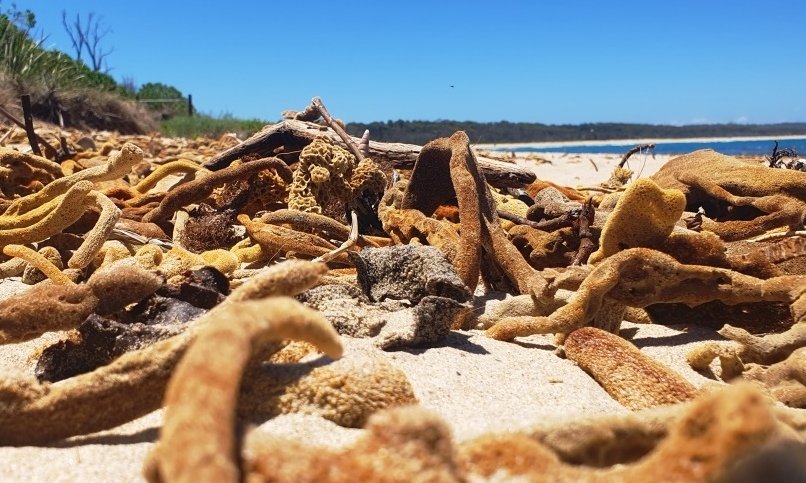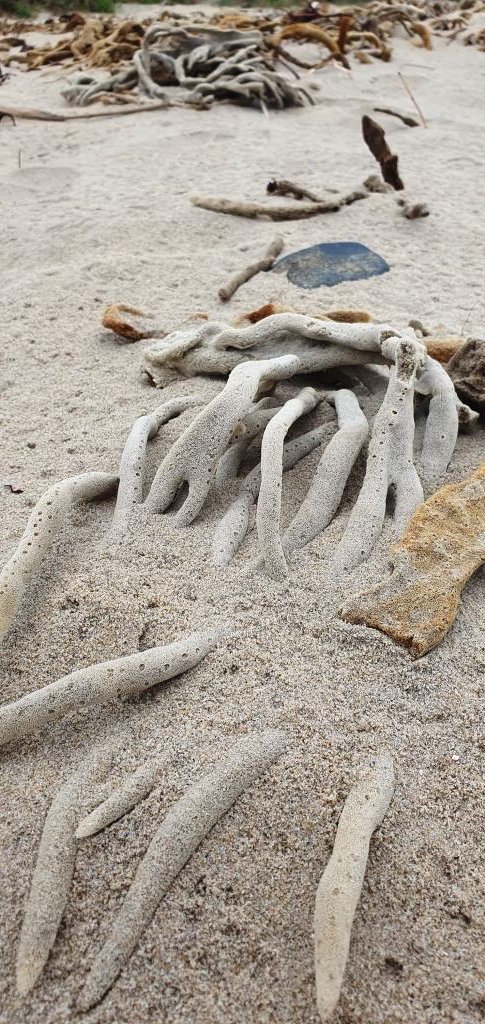Indre Kisonas
I have put a full stop at the end of my 2024. I’m done with busy 2024. I can take no more and have taken myself to the coast for a few days away.
As one that was raised in a coastal town of NSW, the crashing thunder of waves, the sea salt spray, the soft sand between the toes means peace and tranquilly.
I can’t help but get distracted by the coastal colours and textures. So very different to country with their soft greys, soft pinks, muted green, sandy yellows and white. I have often said you only need to look about you to be inspired from nature for your colour palette but this isn’t what I wanted to bring attention to.
I came across a tidal wash of sea sponges. Thick enough in parts that walking upon the mass left you calf deep in the dank, sandy organisms. Organisms they are – sea sponges are the simplest of multi cellular organisms. They do not have a heart, brain or nervous system but are nevertheless, vital to our marine ecosystems. There are over 5000 identified species and having studied the sea sponge graveyard on this particular beach, I was amazed at the diversity in this small area. Large and flat, long and holey, finger like shapes and flat and round.
Sea sponges belong to the phylum Porifera, meaning pore-bearer. These pores or “ostia” filter water in order to ingest water-borne plankton and other simple marine life. They filter huge amounts of water and excrete essential nutrients into the marine ecosystem. They are now recognised as a vital carbon sink absorbing much carbon dioxide from the water. They can live in a variety of places, from freshwater lakes, intertidal zones, deep ocean trenches, sunlit reefs, dark caves and from the tropics to the poles. Some species can live for five to 10 years or they could be as old as 5000 years, based on their growth rates.
They do not move once imbedded in an ideal position on the sea floor, on rocks or even floating debris. Sponge larvae have cilia or tiny hairs, that they used to propel themselves through the water, to find this ideal place to settle. They are both asexual and sexual organisms. Meaning they can grow from a broken bud or release sperm and capture it, to reproduce that way.
Sea sponges contain iodine which the ancient Greeks and Romans noted and it resulted in sponges being used for medicinal purposes during the Middle Ages. Currently, scientists are researching sea sponges for applications in the treatment for cancer.
So where do sponges go to die? By my observations, to this particular beach. The silica and calcium carbonate rich organisms would further breakdown and add to the coastal shore’s composition. With so many varieties, and being such a basic and fundamental link in our marine ecosystem, I not only have a greater respect for the simple sponge but will not lament the hundreds of sponges washed up from a recent storm. Nature has an amazing self preservation system. I’m sure the broken bits of sponge from the many varieties washed up on the shore will go on to grow and reproduce, further filtering and enriching our waters.
I wish you all a happy closure for 2024. It has been a pleasure to get to its final month and I am hoping for a calm and easy 2025, for myself as well as you.
Indre Kisonas is a Daylesford resident and the owner and principal designer of iok design. She specialises in colour & interior design.






